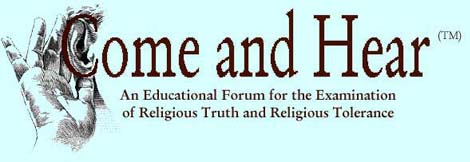The Roadmap
4. More Critical Words of Talmud Study
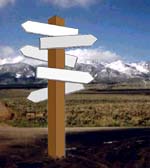
The Roadmap — Let the Rabbis tell us about the Talmud. Why is this fundamental book of Judaism unknown to most Americans?
| Navigate This Site | |
 | |
| Home | |
| Valentine | |
| Dilling | |
| Talmud | |
| The Rabbis | |
| Supplement | |
| Glossary | |
| Download | |
| Admin | |
| | |
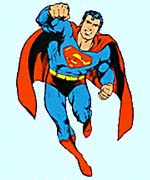
You can help in the battle for Truth, Justice, and the American Way! Fight the forces of censorship and suppression of the Talmud, and bring about understanding between peoples of different faiths.
Download this site to your desktop computer.
Make CDs and distribute them to friends, neighbors, ministers, and community leaders.
Email your favorite essay to your email list.
Post your favorite essay to discussion forums.
Print your favorite essays and give them to those not on the Internet.
Flyers advertising Come-and-Hear.com can be distributed throughout your community.
 Genuine Come and Hear™ CDs do not contain executable programs. When making CDs, do not include any files that end in .exe, .com, .bat, .vbs, .doc, .pif, .sit, or .scr. The person receiving the CD should use his own browser to view the files. This helps to protect him from harmful programs and viruses.
Genuine Come and Hear™ CDs do not contain executable programs. When making CDs, do not include any files that end in .exe, .com, .bat, .vbs, .doc, .pif, .sit, or .scr. The person receiving the CD should use his own browser to view the files. This helps to protect him from harmful programs and viruses.

The following summation of early Jewish history relies largely on The Bible Timeline for dates and Biblical cites. The authors add in a cautionary preface, "These dates are based on careful study and research, but they must almost always be considered approximate and relative. The dates attempt to show the relationship of one event to another and stretch the whole web of events over a frame defined by the most secured dates," recognizing "that the dates even for the most crucial events … are widely disputed … The Bible Timeline avoids any speculative reconstruction of events; it follows the traditional narrative …" — The Bible Timeline. See Bibliography.


Adam and Eve Banished from the Garden of Eden (1)
In 3941 B.C., God put Adam and Eve in the Garden of Eden (Genesis 2:15), and expelled them from the Garden in 3940 B.C. for eating the fruit of the Tree of Knowledge of Good and Evil (Genesis 3:17).
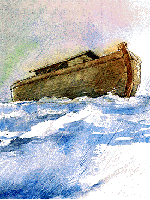
Noah's ark surviving the Great Flood
In 2285 B.C., the earth was flooded and the waters drowned every living thing. Only Noah, his family, and the families of his sons escaped, along with the creatures they had collected and preserved in the Ark (Genesis 7). The water did not recede for five months, enabling the passengers of the Ark finally to disembark in 2284 (Genesis 6-9).
And Noah builded an altar unto the LORD; and took of every clean beast, and of every clean fowl, and offered burnt offerings on the altar.
And the LORD smelled a sweet savour; and the LORD said in his heart, I will not again curse the ground any more for man's sake; for the imagination of man's heart is evil from his youth; neither will I again smite any more every thing living, as I have done. — Genesis 8:20-21
The Gilgamesh legend from Babylon contains a similar flood with remarkably similar details of human survival. Scholars estimate the Gilgamesh legend originated in about 3,000 B.C., or earlier. "A popular theory, proposed by liberal 'scholars,' is that the Hebrews 'borrowed' from the Babylonians, but no conclusive proof has ever been offered," writes the Institute for Creation Research. (46)
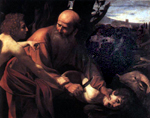
Abraham and The Sacrifice of Isaac (2)
In 1995 B.C., Abram was born into a tribe of nomadic shepherds in Ur, Mesopotamia (present day Iraq, Genesis 11:27). In Genesis 12, God began talking directly to Abram, promising that He would make "a great nation" of Abram's progeny. The Bible follows Abram's travels, adventures, and conversations with God. In 1896, God renamed him Abraham (Genesis 17); God also required him to circumcise himself and the men in his tribe, imposing the custom on all succeeding generations. In 1822 B.C., God told Abraham to make a human sacrifice of his only son, but then an angel stopped him before the boy died (Genesis 22).
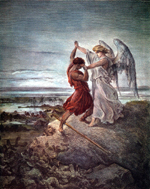
Jacob Wrestling with the Angel, Gustave Doré (47)
Isaac was the son of Abraham, and Jacob was the second son of Isaac. Genesis 32:24-32 describes a wrestling match between Jacob and LORD God that lasted until dawn. Most Christian artists render it as a struggle between Jacob and an angel, but the Scripture clearly states "God." In the morning, LORD God rename Jacob "Israel," meaning "he struggles with God." Thus the descendants of Jacob are called "Israelites."
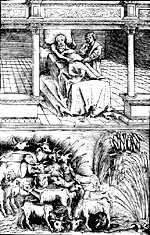
Pharaoh's Dream of Coming Famine by Martin Luther
Jacob, grandson of Abraham, had twelve sons. Joseph, his favorite, was sold to Egyptian slavers by the other eleven. Joseph quickly rose in Egyptian society, until one day Pharaoh sought him out to interpret a haunting dream. Joseph told Pharaoh of the coming seven fat years, followed by seven years of famine. Joseph was put in charge, and he saved the surplus grain during the fat years, so that while the rest of the world was starving, Egypt had grain to sell. Among others who came to Egypt were Jacob and the eleven sons (with their wives, sheep, oxen, etc.) (Genesis 46-47, 1705 B.C.). When the famine was over, the Israelites stayed in Egypt, first as guests, then as slaves.
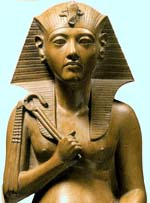
Amenhotep IV ("Akenaten") was Pharaoh in Egypt (1379-1362).
During his reign, Amenhotep and his wife, Nefertiti, changed the religion of Egypt to monotheistic worship of Aten. He is said to have destroyed or desecrated virtually all the temples of the other gods. He was opposed by the adherents of the old religion during his reign, and after his death the old gods were returned to Egypt.
 Queen Nefertiti was Amenhotep's wife.
Queen Nefertiti was Amenhotep's wife.
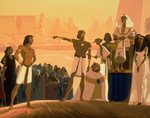
Moses before Pharaoh
Shortly after the death of Amenhotep (1362 B.C.) and the crowning of a new Pharaoh, Moses was born among the Israelites (1355). He was adopted and raised as an Egyptian prince by Pharaoh's daughter. In 1275 B.C., Moses confronted the Pharaoh, asserted his monotheism, and demanded release of the Israelites from bondage (slavery). During one confrontation, Moses expressed his fear that the Egyptians would stone the Israelites if they made proper sacrifice to Jehovah (Exodus 8:26). That is the first mention of stoning in the Bible. Some have suggested that the custom of stoning undesirables was Egyptian in origin.
Pharaoh eventually agreed to allow the Hebrews to leave Egypt. God had given the Hebrews permission to "borrow" and plunder silver, gold, jewels, and fine cloth from the Egyptians for their trip into the desert (Exodus 3:22), and this they did (Exodus 12:35-36).
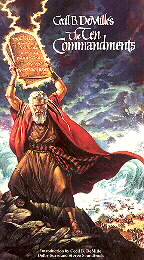
Moses of Hollywood (3)
In about 1275 B.C., Moses brought the Israelites out of Egypt. During their passage through the wilderness, Moses encountered God on Mt. Sinai and received the Law (Exodus 20-24). Questions arise: Why did God give some of His laws in writing, but give others orally, forbidding Moses to write them down?
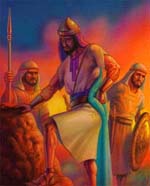
King Saul, a giant among men
For many decades, the Hebrews lived with no central king. Finally, they demanded that God give them their first king so they could "be like other nations" (1 Samuel 8). King Saul was a huge man and an able warrior, but unstable. He ruled from 1025 B.C. to his death in 1004.
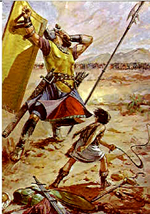
David, son of Jesse, started as a shepherd and excelled as a warrior. On King Saul's death in 1004 B.C., he was chosen king of the Southern Tribes, but was not accepted by the Northern Tribes until 997 B.C., after a civil war (2 Samuel 1). David wrote many of the Psalms in the Bible, and ruled until 965 B.C.

King Solomon, son of David
The kingships of David and Solomon were unquestionably Israel's Golden Age. Solomon, a younger son of David, ruled from 965 B.C. to 926. Wise and able as a ruler, he rebuilt towns that had been ruined by war, built a magnificent temple, and brought wealth to Israel through trade and wise governance (1 Kings 4). But later, he became imperious, instituted forced labor among the Hebrews, collected a huge harem of foreign women who worshipped strange gods, and built alters and shrines to some of those strange gods. Shortly before Solomon's death in 926, Prime Minister Jeroboam led a rebellion, and Israel began to break apart. Solomon's eldest son was crowned on his death (1 Kings 11:43).
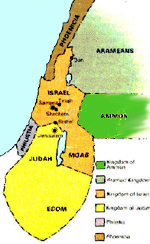
The Two Kingdoms (4)
In 926 B.C., the ten northern tribes seceded from the Kingdom of Israel and enthroned Jeroboam (see above) as their own king. The lighter brown shows the Northern Kingdom, which kept the name "Israel." The southern kingdom, in yellow, was named Judah, for the ruling tribe (1 Kings 12).
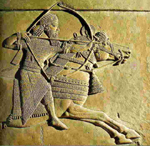
The Assyrian army overran the northern kingdom in 722 B.C., and deported the population to the four winds; those ten tribes (the "lost tribes") disappeared as an identifiable ethnic group (2 Kings 17). Assyria imported other people into the region, and their descendants become known in later centuries as "Samaritans." By Jesus' time, there was much hostility between the Samaritans and the Jews. As a lesson, Jesus told a parable about "the good Samaritan."
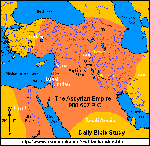
The Assyrian Empire dated from about 900 B.C.
At its height, it straddled completely the "crossroads of the world", even taking tribute from the rebellious Hebrew tribes. In 612 B.C., that Empire faded in defeat to the Chaldeans (Babylonians).
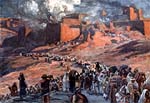
The Babylonians rose to power on the heels of the Assyrians, reconquering the Assyrian properties. In 597 B.C., the Babylonian king Nebuchadnezzar besieged Jerusalem, and the Hebrews surrendered. Nebuchadnezzar deported thousands of the Hebrew nobility and skilled craftsmen to Babylonia. (2 Kings 24:10-16, Jeremiah 52:28).
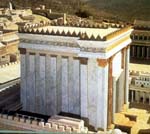
King Solomon's Temple (the "First Temple") built about 954 B.C. (Kings 7:13-47). It was burned in 586 B.C. during an attack by the Babylonians, probably destroying all extant copies of the Old Testament scriptures. The attackers leveled the city of Jerusalem, the last remaining major city of Judah, and took the Hebrews into captivity in Babylon. The Wailing Wall of Jerusalem is thought to be the remains of Solomon's Temple.

King Cyrus of Babylon (8) decreed in 538 B.C. that the Jews could return to Israel to rebuild their cities and temples. He gave them their gold from the royal treasury and helped to finance the expedition (Ezra 1). Cyrus is the figure on the white horse.
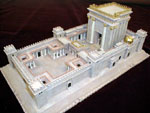
The Second Temple
The first wave of returning Jews began rebuilding the old city of Jerusalem, but met resistance from the Samaritans. In a second wave in 522 B.C. overcame the resistance and laid the foundations for the Second Temple in 520 B.C. The Second Temple was completed on March 12, 516 B.C. The re-established nation was named Judea (rather than Judah).
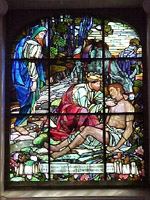
The Good Samaritan, artist unknown, 1905 (9)
Who were the Samaritans? We are told that when the Assyrians defeated the Northern Kingdom, they deported the Hebrews and moved other peoples into the area. Mysteriously, the newcomers also followed the Mosaic Law, just as the Ten Tribes had done. Who but the Ten Lost Tribes would speak Hebrew and worship Yahweh?
Pharisees have a historical tendency to deny the title "Jew" or "Israelite" to non-Pharisees (see Old Testament Believers Labeled "Idolaters" or Introduction to Tractate Niddah: "…non-Jewish women, such as Samaritans, Sadduceans and idolaters…" — Rev. Dr. Slotki
It stands to reason that the Samaritans were the remnants of the "Ten Lost Tribes," written out of history by the exclusionary Pharisees, from whom we get our Old Testament.
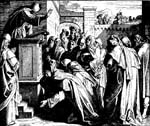
Ezra the Scribe (10) came to Jerusalem with the Torah sometime between 458 B.C. and 398 — accounts differ. Some scholars suggest this Torah was the Oral Law, others that it was the Old Testament. Some say he authored the Torah, others that he rewrote it from memory. Some say he reconstructed it from fragmentary parchments, others that he merely edited the Torah and rewrote it in Assyrian script. Whatever his role, apparently the very existence of Jewish law was for a while dependent on Ezra alone, and he is counted among the giants in Judaism.
And all the people gathered themselves together as one man into the street that was before the water gate; and they spake unto Ezra the scribe to bring the book of the law of Moses, which the LORD had commanded to Israel. And Ezra the priest brought the law before the congregation both of men and women, and all that could hear with understanding, upon the first day of the seventh month. (Nehemiah 8:1-2)
A comparison between the Mosaic Law (dated at 1275 BC) and the Code of Hammurabi (published before Hammurabi's death in 1750 BC) reveals some striking similarities. The similarities suggest that Ezra the Scribe may have borrowed from the Babylonian Code of Hammurabi, and incorporated the doctrines as Mosaic Law. (45)
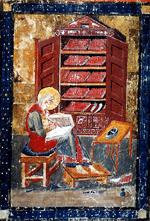
Ezra the Scribe in an 8th Century painting. (39) The burning of Solomon's Temple was not the only occasion when the Old Testament was lost. As told in the Talmud: "… in ancient times when the Torah was forgotten from Israel, Ezra came up from Babylon and established it. [Some of] it was again forgotten and Hillel the Babylonian came up and established it. Yet again was [some of] it forgotten, and R. Hiyya and his sons came up and established it." — Babylonian Talmud, Tractate Sukkah 20a.
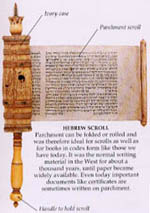
Oral Tradition that became the Talmud
In the following centuries, Judea was conquered by Alexander the Great and later by the Greeks of Egypt; it also suffered a series of civil wars and purges. Instead of re-establishing the Hebrew royal line, the Jews settled into local rule by the "Great Assembly" (in Greek, Sanhedrin) to codify and administer the law of the land. The Sanhedrin was headed by the hereditary High Priest of each generation (sometimes called "Prince"). Judea was both a state religion and a religious state — a theocracy. It was during this period, according to Chief Rabbi Dr. Hertz, that many of the local customs were incorporated into the religious canon, later to be ascribed to Moses or justified (through exegesis) by Mosaic Law.

Final Destruction of Jerusalem
Jerusalem, having fallen under the Roman Empire through an "alliance" in 161 B.C., rebelled repeatedly. Rome grew weary of the Jewish problem, so the army of the Roman general, Titus, destroyed Jerusalem completely in 70 A.D. The Romans stripped the Second Temple of its immense wealth and leveled the entire city, along with many others in the region. They killed many of the rebels, took many slaves, and drove many into other lands.
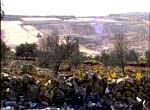
Bar Kochba rebellion in Betar.(11) The destruction of Jerusalem was an important defeat in the Diaspora (dispersion of Jews through the world). Hostilities with Rome continued until the Bar Kochba rebellion in 135 A.D. Shimon Bar Kochba rode the "Messiah" prophesy to the position of warlord and commander in fortified Betar. However, a falling-out among the rabbis (including the famed Talmud Sage, Rabbi Akiba) divided the force, and the Jews were defeated by the Romans.(40) From then on, Emperor Hadrian exiled the Jews from Jerusalem and the ruins of the Temple.
In Critical Words of Talmud Study, we looked at some logical and linguistic features of the Talmud. We studied the definitions and usage of words such as Pharisee, Exegesis, Pentateuch, Midrash, Torah, Idolater, Divine Law, and Halachah (Halakha).
Now, we continue.
Oral Law
Six sources of Oral Law are mentioned in rabbinical writing:
- Laws given by God to Moses, for transmission by word-of-mouth
- Justified traditions
- Laws derived from the Old Testament (exegesis)
- Laws derived by methods transmitted by God when he gave Moses Oral Law (exegesis)
- Any religious doctrines taught orally
- Rabbinic discretion
Laws Given By God To Moses, For Transmission by Word of Mouth
GEMARA … God made a covenant with Israel only for the sake of that which was transmitted orally. For by the mouth of these words I have made a covenant with thee and with Israel.
— Babylonian Talmud, Gittin 60b
Soncino 1961 Edition, pages 26-27
In the Soncino Edition, italicized text is used to indicate quotes from Biblical scripture. In a footnote that follows the scriptural quote Maurice Simon, translator, cites Exodus 34:27. The King James Version of this verse reads:
- And the LORD said unto Moses, Write thou these words: for after the tenor of these words I have made a covenant with thee and with Israel.
— Exodus 34:27 (KJV)
This writer consulted other popular translations of the Bible. All translations of Exodus 34:27 were similar to the King James Version. See footnote 12 for the results of this research. No Christian Bible translations matched the words quoted in the Soncino Talmud. As explained by the Soncino editor, Rabbi Dr. Isidore Epstein, in his introductions to the six Seders:
No particular English version of the Bible is followed, as the Talmud has its own method of exegesis and its own way of understanding Biblical verses which it cites.
— Rabbi Dr. Epstein (13)
Now let's turn to another Talmud tractate, the Aboth. In the Introduction, translator J. Israelstam writes about Tractate Aboth:
[Aboth] establishes the divine … origin of the Torah, Oral as well as Written, and the continuity of its transmission by human agents, to wit the succession of elders, prophets, etc., in Israel.
J. Israelstam(41)
Here is the opening Mishnah of Tractate Aboth:
MISHNAH 1. MOSES RECEIVED THE TORAH AT SINAI AND TRANSMITTED IT TO JOSHUA, (3) JOSHUA TO THE ELDERS, AND THE ELDERS TO THE PROPHETS, AND THE PROPHETS TO THE MEN OF THE GREAT SYNAGOGUE.
— Babylonian Talmud, Tractate Aboth, Chapter I, Mishnah 1
Soncino 1961 Edition, page 1
The translator, J. Israelstam, amplifies the text in a footnote:
- I ARN, Ch. I, 'Joshua received from Moses'. The transmission and reception were done orally. All evidence goes to show that there was a continuous succession of 'schools' headed by the Elders, prophets and scribes of their respective generations, which maintained and developed the theoretical study and practical application of the Torah. The strength of the schools and their influence varied from time to time, but there is no reason for supposing that there was at any time an actual break in the continuity. For a full examination of the terms [H] (transmitted) and [H] (received) v. Bacher, Tradition und tradenten, p 1.
— J. Israelstam
The Jewish Encyclopedia explains the origin of Oral Law as follows:
[The term Oral Law is] used to denote the laws and statutes which, in addition to the Pentateuch, God gave to Moses. According to rabbinical interpretation of Ex. XXXIV, 27, the words [Hebrew omitted] indicate that besides the written law God gave orally to Moses other laws and maxims, as well as verbal explanations of the written law, enjoining him not to record these teachings, but to deliver them to the people by word of mouth (Git. 60b; Yer. Meg. iv. 74a; comp. also IV Ezra [II Esdras] xiv.)
— The Jewish Encyclopedia (19)
Fortunately, the details of Moses' trip to Mt. Sinai have been preserved in the Talmud. The story runs thus:
Moses' arrival in Heaven alarms the angels, who challenge LORD God's judgment: Why are you giving this precious Torah to a mortal, they demand. LORD God doesn't answer the angels, but directs Moses to answer for him. Moses tells LORD God he's afraid the angels will burn him with their hot breath. LORD God encourages Moses to be bold: "Hold on to the Throne of Glory and return them an answer," LORD God instructs him.
Moses then gives the angels a piece of his mind, asking them: Did they go down to Egypt to be enslaved by the Pharaoh? Do they dwell among people who engage in idol worship? Do they have a wearying workweek from which they need a day of rest? Do they have business dealings that tempt them to take the Lord's name in vain? — And so on through the Commandments (though Moses has not yet been given the Commandments and could not know what they are). The passage begins as follows:
When Moses ascended on high, the ministering angels spake before the Holy One, blessed be He, 'Sovereign of the Universe! What business has one born of woman amongst us?' 'He has come to receive the Torah,' answered He to them. Said they to Him, 'That secret treasure, which has been hidden by Thee for nine hundred and seventy-four generations before the world was created. Thou desirest to give to flesh and blood! What is man, that thou art mindful of him, And the son of man, that thou visitest him? O Lord our God, How excellent is thy name in all the earth! Who hast set thy glory [the Torah] upon the Heavens!' 'Return them an answer,' bade the Holy One, blessed be He, to Moses. 'Sovereign of the Universe' replied he, 'I fear lest they consume me with the [fiery] breath of their mouths.' 'Hold on to the Throne of Glory,' said He to him, 'and return them an answer,' …
— Tractate Shabbath 88b
Soncino 1961 Edition, pages 421-422
This colorful account is lengthy but well worth reading. We have included it for the reader's edification in the Appendix.
Oral Torah Precedes Written Torah
The following explanation is offered by Aish HaTorah, an organization dedicated to educating Jews about Judaism. According to the Aish HaTorah page Who is Aish HaTorah? "Aish HaTorah operates 26 full-time branches and offers programs in 80 cities, representing 17 countries on 5 continents." (49)
It's important to clarify a common misconception many have about the role of the Oral Torah in Judaism.
The Oral Torah is not an interpretation of the Written Torah. In fact, the Oral Torah preceded the Written Torah. When the Jewish people stood at Mount Sinai 3,300 years ago, God communicated the 613 commandments, along with a detailed, practical explanation of how to fulfill them. At that point in time, the teachings were entirely oral.
It wasn't until 40 years later, just prior to Moses' death and the Jewish people's entering the Land of Israel, that Moses wrote the scroll of the written Torah (known as the Five Books of Moses) and gave it to the Jewish people.
— Aish HaTorah (48) (emphasis added)
The 613 commandments cited above are listed on the Aish HaTorah page, "613 Commandments." (50)
Oral Law Deduced from Written Torah
Certain phrases have been emphasized in the following text. The emphases do not appear in the original.
In a wider sense, however, [Oral Law] includes all the interpretations and conclusions which the scribes deduced from the written Torah, as well as the regulations instituted by them (comp. Yoma 28a, b and Rashi ad loc.), and therefore comprises the entire traditional teaching contained in the Mishnah, the Tosefta, and the halakic midrashim, since these were taught only orally and were not committed to writing. In later haggadic statements, however, the complete body of rabbinical doctrine is said to have been revealed to Moses on Sinai; so that R. Joshua b. Levi declared (comp. Yoma 28a, b and Rashi ad loc.), that all the rabbinical teachings, even those which the scholars found and promulgated later, were given to Moses on the Mountain (comp. also Ber. 5a).
These passages, on the other hand, are by no means intended to be taken literally, or to be supposed to imply that God imparted to Moses the entire rabbinical teachings as they were developed in the course of time; since the forty days which Moses spent on Sinai would not have been sufficient, and the Midrash itself says (Ex. R. xli.) that the full extent of the rabbinical teachings was revealed to Moses in outline by giving him the rules according to which they might be developed. In conformity with this statement, the substance of these teachings either was deduced from the written law by means of exegetical interpretations and logical conclusions — being therefore contained by implication in the written law and so given to Moses — or it consisted of statutes which the Rabbis promulgated according to their own judgment, as they were justified in doing according to the traditional interpretation of Deut. xvii. 10-11 … since Moses had thus provided for such contingencies.
— The Jewish Encyclopedia, (17) emphasis added.
The Talmud passage (Berakoth 5a) cited above reads as follows:
GEMARA. … R. Levi b. Hama says further in the name of R. Simeon b. Lakish: What is the meaning of the verse: And I will give thee the tables of stone, and the law and the commandment, which I have written that thou mayest teach them? (6) 'Tables of stone': these are the ten commandments; 'the law': this is the Pentateuch; 'the commandment': this is the Mishnah; 'which I have written': these are the Prophets and the Hagiographa; 'that thou mayest teach them': this is the Gemara. It teaches [us] that all these things were given to Moses on Sinai.
— Babylonian Talmud, Berakoth 5a
Soncino 1961 Edition, page 16
Berakoth page 16 footnote 6 in the Soncino text cites Exodus 24:12. However, that text reads as follows:
- And the LORD said unto Moses, Come up to me into the mount, and be there: and I will give thee tables of stone, and a law, and commandments which I have written; that thou mayest teach them.
Exodus 24:12, KJV
Once again, we are reminded of the words of Rabbi Dr. Epstein, editor of the Soncino Talmud: "… the Talmud has its own method of exegesis and its own way of understanding Biblical verses which it cites." (13)
Oral Law As a Collection Of Justified Traditions
Rabbi Michael Rodkinson tells us Oral Law is a collection of traditional law to which Biblical verses were coupled by ingenious association. Writing of Rabbi Akiba (Aqiba or Akiva), who lived between 50 and 135 A.D., (15) Rabbi Rodkinson states:
Through his keen intellect, his vast learning and his energetic activity he wielded a great influence in developing and diffusing the traditional law. He arranged the accumulated material of that law in a proper system and methodical order, and enriched its substance with many valuable deductions of his own … Besides, he introduced a new method of interpreting the Scriptures, which enabled him to find a biblical basis for almost every provision of the oral law. This ingenious method was admired by his contemporaries, and notwithstanding the opposition of some of his colleagues, generally adopted in addition to the hermeneutic rules of R. Ishmael.
— Rabbi Michael Rodkinson, (16) (emphasis added)
See also Exegesis After the Fact for Akiba's ex post facto justification of Oral Law.
Mishnah
The term "Mishnah" is used to denote the Oral Law found in the Talmud. The Universal Jewish Encyclopedia says of Mishnah:
The Mishnah contains the essence of the Oral Law as it had been handed down from the time of the Bible.
— The Universal Jewish Encyclopedia. (25)
The Jewish Encyclopedia gives this account of the origin of Mishnah:
Moses, following the custom of the angels, ate nothing during his forty days' sojourn in heaven (B.M. 37b) … He distinguished day from night by the fact that God instructed him by day in the Scripture, and by night in the Mishnah.
— The Jewish Encyclopedia (18)
Because of their critical importance, Mishnayoth (plural form of Mishnah) are clearly distinguished from other text in the Talmud. In the Soncino Talmud, the Mishnayoth appears in capitalized letters.
A Momentous Time In History
To appreciate the relationship between the terms we have been studying, it is necessary to step back into history. The Bible Timeline places Moses' receipt of the Ten Commandments at 1275 B.C. (20) Let us leap forward from Moses' day about 670 years. Between the years 605 - 586 BC, Babylon attacked the Kingdom of Judea; Jerusalem and the temple built by King Solomon (the "First Temple") were destroyed. (21) The rituals associated with the First Temple were brought to an end. Many Jews were deported to Babylon.
The Babylonian Captivity is said to have lasted 70 years. In 538 BC, King Cyrus permitted the Jews to return to Jerusalem. The Second Temple was built. Many Jews returned, but many stayed in Babylon. For at least the next 2,000 years, Babylon remained a center for Judaic lore and Judaic learning (hence the term, "Babylonian Talmud.").
After the end of the Babylonian Captivity and during the period of the Second Temple, the Jews lived under a theocracy ruled by priests rather than kings. At the time of the birth of Jesus of Nazareth, the courts of the Sanhedrin governed the Jews, under Roman auspices. In about 70 A.D. Rome destroyed Jerusalem and the Second Temple. By that time rabbinical schools existed in many parts of the known world.
It is against this backdrop of history that the Talmud developed. (14)
Influence Of Babylonian Captivity on Judaism
The beginnings of Talmudic literature date back to the time of the Babylonian Exile in the sixth pre-Christian century, before the Roman Republic had yet come into existence. When, a thousand years later, the Babylonian Talmud assumed final codified form in the year 500 after the Christian era, the Western Roman Empire had ceased to be …
The Babylonian Exile is a momentous period in the history of humanity — and especially so in that of Israel. During that Exile, Israel found itself. It not only rediscovered the Torah and made it the rule of life, but under its influence new religious institutions … came into existence …
— Rabbi Dr. Hertz (23)
At this point in history, there appeared amongst the Jews, Ezra the Scribe, a man so important in Judaism that rabbis compare him to Moses.
Ezra Brought Back Oral Law ("Torah")
At the re-establishment of the Jewish Commonwealth, Ezra, the Sofer, or Scribe, in the year 444 B.C.E. formally proclaimed the Torah the civil and religious law of the new Commonwealth. He brought with him all the oral traditions that were taught in the Exile …
— Rabbi Dr. Hertz (23)
Experts disagree on the date Ezra left Babylon. The Bible Timeline shows this entry:
458. Ezra, a priest and expert in the Jewish Law in Babylonia, leads a company to Jerusalem. He brings a copy of the Jewish Torah as it had been codified. (The date is disputed. Some would set this event in 428 or 398.) Ezra 7:1-26.
Thomas Robinson (21)
Which "Torah" Did Ezra Bring?
Given that The Bible Timeline is a Christian reference with almost half the content devoted to New Testament events, use of the term "Jewish Torah" in the quote (above) sparks a question: If the author is referring to the Old Testament or the Pentateuch, why does he use the term "Jewish Torah?" The term, "Jewish Torah," does not appear anywhere else in The Bible Timeline.
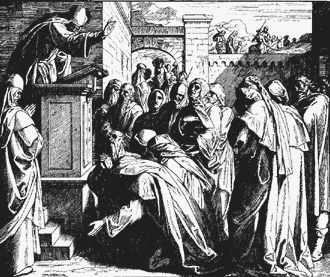
|
| Ezra reads the law to the people of Jerusalem. (10) |
Since The Bible Timeline does not specify which "Torah" Ezra brought with him, and since that Torah had been "codified," we are left with the clear impression that Ezra's "Torah" may have been Oral Law.
However, The Jewish Encyclopedia states that Ezra reestablished the text of the Pentateuch, introduced Assyrian script, and questioned some words in the text. The Jewish Encyclopedia infers that Ezra and Elijah together edited the text of the Old Testament.
Ezra was the disciple of Baruch ben Neriah (Cant. R.); his studies prevented him from joining the first party returning to Jerusalem in the reign of Cyrus, the study of the Law being of greater importance than the reconstruction of the Temple. According to another opinion, Ezra remained behind so as not to compete, even involuntarily, with Jeshua ben Jozadak for the office of chief priest. Ezra reestablished the text of the Pentateuch, introducing therein the Assyrian or square characters, apparently as a polemical measure against the Samaritans (Sanh. 21b). He showed his doubts concerning the correctness of some words of the text by placing points over them. Should Elijah, said he, approve the text, the points will be disregarded; should he disapprove, the doubtful words will be removed from the text (Ab. R. N. xxxiv.). Ezra wrote the Book of Chronicles and the book bearing his name (B. B. 16a).
— The Jewish Encyclopedia (26)
The "Torah" had been forgotten during the Babylonian Captivity, according to this passage from the Tractate Sukkah of the Talmud:
GEMARA. … For in ancient times when the Torah was forgotten from Israel, Ezra came up from Babylon and established it. [Some of] it was again forgotten and Hillel the Babylonian came up and established it. Yet again was [some of] it forgotten, and R. Hiyya and his sons came up and established it.
— Babylonian Talmud, Sukkah 20a
Soncino 1961 Edition, page 87
Is it possible that the "Torah" that was lost from Israel and brought back by Ezra was really the Old Testament? This passage from the 1908 Catholic Encyclopedia states that according to Jewish traditions, Ezra reconstructed the Old Testament from memory. (In the following, "Esdra" is another transliteration of "Ezra.")
As is the case with many men who played an important part at momentous epochs in history, in the course of time Esdras's personality and activity assumed, in the minds of the people, gigantic proportions; legend blended with history and supplied the scantiness of information concerning his life; he was looked upon as a second Moses to whom were attributed all institutions which could not possibly be ascribed to the former. According to Jewish traditions, he restored from memory — an achievement little short of miraculous — all the books of the Old Testament, which were believed to have perished during the Exile; he likewise replaced, in the copying of Holy Writ, the old Phoenician writing by the alphabet still in use. Until the Middle Ages, and even the Renaissance, the crop of legendary achievements attributed to him grew up; it was then that Esdras was hailed as the organizer of the famous Great Synagogue — the very existence of which seems to be a myth — and the inventor of the Hebrew vocal signs.
— Catholic Encyclopedia (27)
Other passages in the Talmud state that Ezra put the "Torah" into Ashshurith script and the Aramaic language.
GEMARA. … Originally the Torah was given to Israel in Hebrew characters and in the sacred [Hebrew] language; later, in the times of Ezra, the Torah was given in Ashshurith script and Aramaic language. [Finally], they selected for Israel the Ashshurith script and Hebrew language, leaving the Hebrew characters and Aramaic language for the hedyototh. Who are meant by the 'hedyototh'? — R. Hisda answers: The Cutheans [heathens]. And what is meant by Hebrew characters? — R. Hisda said: The libuna'ah script.
— Babylonian Talmud, Sanhedrin 21b
Soncino 1961 Edition, page 119
Ezra And Moses Equally Regarded
In the view of Talmud Sages, Ezra's role in Judaic history was as important as the role of Moses.
GEMARA. … It has been taught: R. Jose said: Had Moses not preceded him, Ezra would have been worthy of receiving the Torah for Israel. Of Moses it is written, And Moses went up unto God, and of Ezra it is written, He, Ezra, went up from Babylon. As the going up of the former refers to the [receiving of the] Law, so does the going up of the latter. Concerning Moses, it is stated: And the Lord commanded me at that time to teach you statutes and judgments; and concerning Ezra, it is stated: For Ezra had prepared his heart to expound the law of the Lord [his God] to do it and to teach Israel statutes and judgments. And even though the Torah was not given through him, its writing was changed through him, as it is written.
— Babylonian Talmud, Sanhedrin 21b
Soncino 1961 Edition, page 119
The Sanhedrin continues in this vein:
GEMARA. … And the writing of the letter was written in the Aramaic character and interpreted into the Aramaic [tongue]. And again it is written, And they could not read the writing nor make known to the king the interpretation thereof. Further, it is written: And he shall write the copy [mishneh] of this law, — in writing which was destined to be changed. Why is it called Ashshurith? — Because it came with them from Assyria.
— Babylonian Talmud, Sanhedrin 22a
Soncino 1961 Edition, pages 119-120
In the following passages, the Sages go on to argue about the issue. Please visit and read the text.
Whatever the truth of the various claims, it seems that at one point the entire Old Testament may have been in Ezra's hands.
Ezra Creates "Frontier Of Fire"
Ezra sought to preserve the distinctive nature of the Jewish experience. He lamented the affinity many Jews felt towards non-Jews and set about to correct the situation. He urged radical religious reform, and ordered Jews married to non-Jews to put aside their wives and families.
Rev. Dr. Abraham Cohen, the renowned Talmud scholar chosen to translate the Tractates Sotah and Abodah Zarah for Soncino Press, suggests that the purpose of Ezra's religious reforms was, at least in part, political: Ezra's reforms would result in practices that would forever distinguish Jews from the rest of humanity and mold them into a political/cultural entity that would not be dissolved. Unless this viewpoint is thoroughly grasped, Rev. Dr. Cohen says, it is not possible to understand rabbinical exegesis.
The policy of Ezra has been elsewhere described by the present writer in these terms: 'Zangwill once said, "History, which is largely a record of the melting of minorities in majorities, records no instance of the survival of a group not segregated in space or not protected by a burning faith as by a frontier of fire." This lesson of history had evidently been discerned by Ezra. He understood that the Jews could not be utterly segregated in space. Not only were there branches of the national tree in Egypt, Babylon, and Persia to be taken into consideration, but contact between the Jews and Judea and their neighbors could not be avoided. If, then, the Jewish nation was to be preserved, it must be ringed round "by a burning faith as by a frontier of fire" — a most apposite metaphor, since the Bible itself speaks of "a fiery law."
— Rev. Dr. Cohen (28)
The Jew Must Be Different
This quote follows immediately on the quote, above.
The Jew must have a religion which would not only continually distinguish him from the heathen, but would likewise be a constant reminder to him that he was a member of the Jewish race and faith. The Jew was to be demarcated from his neighbors not merely be a creed, but by a mode of living. His manner of worship would be different; his home would be different; even in the common acts of daily life there would be distinguishing features which would constantly recall his Jewishness. His life, in every detail, was to be controlled by Torah — by the written enactments of the Mosaic code and their development in the corporate life of the people, as the altered conditions demanded change.
— Rev. Dr. Cohen (28)
An Inexhaustible Exegetic Mine
This quote follows immediately on the quote, above.
Unless this viewpoint is thoroughly grasped, there can be no possibility of understanding the mentality of the Rabbis, the trend of their activities and their method of Bible-exegesis. It is the seed out of which the Talmud grew. We have it mentioned very distinctly in the account of Ezra's work: 'He had set his heart to seek the Torah of the Lord, and to do it, and to teach in Israel statutes and judgments' (Ezra vii. 10). The Hebrew verb used in this sentence for 'to seek' darash, is of the utmost importance for our theme. Its true sense is 'to deduce, interpret' the ideas which profound study of the text could elucidate. This process of deduction is called Midrash and is the system of interpretation employed throughout the Rabbinic literature. By its aid a Scriptural passage yielded far more than could be discerned on the surface. The sacred words became an inexhaustible mine which, when quarried, produced rich treasures of religious and ethical teaching.
— Rev. Dr. Cohen (28)
Rev. Dr. Cohen seems to be suggesting, then, that Oral Law was deliberately developed for the specific political purpose of making Jewish religion idiosyncratic to the degree that the Jewish identity and body politic would be forever preserved.
Pharisaic Innovation Was Feverish
Let us now return to Rabbi Dr. Hertz. He points out that not all Jews accepted Oral Law. The Sadducees rejected Oral Law as dangerous and innovative; they wanted Israel to rely upon the Pentateuch (Written Law) only.
The opposition of the Sadducees only gave an additional impetus to the spread of the Oral Law by the Scribes, later known as the Pharisees. What they sought was the full and inexhaustible revelation which God had made. The knowledge of the contents of that revelation, they held, was to be found in the first Instance in the Written Text of the Pentateuch; but the revelation, the real Torah, was the meaning of that Written Text, the Divine thought therein disclosed, as unfolded in ever greater richness of detail by successive generations of devoted teachers …
— Rabbi Dr. Hertz (31)
— Innovation Organized By Hillel
There is disagreement among rabbinical scholars about the parts played by the various Sages in organizing the Talmud. Let us first visit with Rabbi Dr. Hertz.
The product of the feverish activity of the Pharisaic schools threatened to become too unwieldy to be retained by unassisted memory. For all this teaching was oral, and was not to be written down. The first effort at arrangement of the traditional material into a system, was made in the first pre-Christian century by Hillel …
He popularized seven exegetical rules for the interpretation of the Torah — e.g., the rules of inference, and analogy — by which the immanent meaning of Scripture might better be brought out; and he divided the mass of traditions that in his day constituted the Oral Law into the six main Orders, which division was accepted by all his successors
—Rabbi Dr. Hertz, (33)
Notice that Rabbi Dr. Hertz attributes Hillel with popularizing the rules for exegesis.
— Innovation Organized By Akiba
Rabbi Adin Steinsaltz takes another road:
The systematic organization of halakhah as a whole into clearly defined units was apparently carried out by Rabbi Akiva.
— Rabbi Steinsaltz (29)
— Exegesis After The Fact
We have already seen Rabbi Rodkinson's comments on Rabbi Akiba's ex post facto justification of Oral Law. Rabbi Dr. Hertz agrees. After Hillel divided the legal traditions into orders, Akiba researched Scripture and assigned a Biblical foundation to them.
In the following generation, Akiba was the author of a collection of traditional laws out of which the Mishnah actually grew. He was the greatest among the rabbis of his own and of succeeding times, the man of whom — as the legend says — even Moses was for a moment jealous when in a vision he was given a glimpse of the distant future. His keen and penetrating intellect enabled him to find a Biblical basis for every provision of Oral Law.
— Rabbi Dr. Hertz (34) (emphasis added)
Not everyone was as enthusiastic as Rabbis Rodkinson and Hertz concerning Rabbi Akiba's success. The Talmud text itself highlights some of the problems with Akiba's results. In a discussion of hypothetical cases concerning the complex regulations for reassigning a childless bride to one of the groom's brothers upon the death of the groom, the commentary ends with the statement:
GEMERA … The prohibition is really Rabbinical, and the Scriptural text is a mere prop.
— Babylonian Talmud, Yebamoth 24a
Soncino 1961 Edition, page 143
The translator, Rev. Dr. Israel W. Slotki, M.A., Litt. D., refers us to the term Asmakta in the Soncino Talmud Glossary:
ASMAKTA 'Reliance'; (a) Biblical text adduced to give some slight support or provide a mnemonic for a law enacted by the Rabbis; …
— Soncino Talmud Glossary
Soncino 1961 Edition, page 723
Further comment on Akiba's skill is offered in the Mishnah of Tractate Hagigah 10a. The Sages say of the exegesis: "The laws concerning the dissolution of vows hover in the air and have nought to rest on. The laws concerning the Sabbath, festal-offerings, acts of trespass are as mountains hanging by a hair, for they have scant Scriptural basis …"
MISHNAH. [THE LAWS CONCERNING] THE DISSOLUTION OF VOWS HOVER IN THE AIR AND HAVE NOUGHT TO REST ON. (5) THE LAWS CONCERNING THE SABBATH, FESTAL-OFFERINGS, ACTS OF TRESPASS ARE AS MOUNTAINS HANGING BY A HAIR, FOR THEY HAVE SCANT SCRIPTURAL BASIS BUT MANY LAWS. [THE LAWS CONCERNING] CIVIL CASES AND [TEMPLE] SERVICES, LEVITICAL CLEANNESS AND UNCLEANNESS, AND THE FORBIDDEN RELATIONS HAVE WHAT TO REST ON, (9) AND IT IS THEY THAT ARE THE ESSENTIALS OF THE TORAH.
— Babylonian Talmud, Tractate Hagigah 10a
Soncino 1961 Edition, page 50
The translator, Rabbi Prof. I. Abrahams, amplifies the text with these footnotes (detailed supporting cites omitted for brevity and clarity):
- I.e., in Biblical teaching, and depend only on oral tradition; but cf. Num. XXX, 8-9.
- [MS.M. 'have on whom to rest', i.e., have good authority. …].
— Rabbi Prof. I. Abrahams
Questions for Rabbi Akiba
|
— The Mishnahs Are Composites
In 135 A.D. (some say 132 A.D.), Rabbi Judah (Judah the Prince) was born. Rabbi Dr. Hertz says of Judah the Prince:
… he made it his aim to ensure unity of religious observance by the establishment of one Code of undisputed authority. He, therefore, surveyed anew the whole aggregation of ordinances that had accumulated with the centuries, sifting and arranging, abridging and amplifying; and often incorporating the opinions of earlier teachers in exactly the form in which he had received them. Thus the Mishnah is not cast in a single mould. It is a composite work.
— Rabbi Dr. Hertz (35)
R. Judah tried, insofar as possible, to create formulas reflecting the general consensus on most issues. Where he believed that he was expressing the main intention of the halakhah he did not denote the source, marking it as stam mishnah (plain mishnah) without naming the author or formulator.
— Steinsaltz (7)
According to the sources, R. Judah not only edited the Mishnah but also utilized it in practice in the course of his studies with his contemporaries. He sometimes changed his opinion on certain issues and consequently introduced amendments into the mishayot. At times he was unable to introduce certain of his new formulations or theories into the work since a previous ruling had already been accepted …
— Steinsaltz (7)
Others Organized the Gemara
In the following, the word Talmud is used to denote the Gemara alone, rather than the composite work containing the Mishnah and the Gemara. Rabbi Dr. Hertz mentions two rabbis who organized the Talmud (Gemara):
… Ashi, who died in 427 … combined a vast memory with extraordinary mental orderliness, that enabled him to systematize the bewildering mass of Talmudic material and prepare it for codification. Such codification was finally effected by Rabina, who died in the year 499.
— Rabbi Dr. Hertz (36)
A parenthetical remark is in order: Given the numbers of codification attempts, rabbinical experts disagree about the current organizational status of the Talmud. Rabbi Dr. Jacob Neusner is at one end of the spectrum. In this excerpt, he characterizes his opponents' opinion of the Talmud and contrasts it with his own:
In fact, when we outline the Talmud beginning to end, as I have done in my four-volume work, The Talmud of Babylonia: A Complete Outline, the results do not indicate a haphazard, episodic, sedimentary process of agglutination and conglomeration. They point, quite on the contrary, to a well-considered and orderly composition, planned from beginning to end and following an outline that is definitive throughout.
— Rabbi Dr. Neusner (37)
According to his biographical sketch, Rabbi Dr. Jacob Neusner has published more than 850 books and has been awarded nine honorary degrees. (38)
For further discussion of the organization of the Talmud, see Is Talmud Law in Order or Disorder?. (5)
When Was the Talmud Put in Writing?
Concerning the exact time at which the Mishnah was committed to writing, diversity of opinion has prevailed among eminent Jewish authorities during the last nine centuries. Sherira Gaon, Rashi, Luzzatto, Rapoport and Graetz hold that Rabbi arranged the Mishnah in his own mind without the help of pen or parchment; delivered it in his Academy, the same in form and contents as it stands to-day; and thus transmitted it by word of mouth to his disciples. These again delivered it to succeeding generations. It was thus orally preserved with verbal accuracy down to the time when the Academies sank in importance, and the teachers of the day found it necessary to fix the existing stock of traditions in writing, some time in the 8th or 9th century. Opposed to this opinion, we have other authorities no less eminent, who maintain that Rabbi himself wrote out the Mishnah in full. Among them are Yehudah Hallevi, Maimonides and Abarbanel; Weiss, Geiger and Fraenkel.
— Rabbi Dr. Hertz (30)
So then, the Mishnah of the Talmud was put into writing either during the lifetime of Judah the Prince (135-219 A.D.) or during the 700s or 800s A.D. (51)
Haggadah
In discussions of the Talmud, Halachah is often contrasted with Haggadah (or Aggadah). The Glossary of the Soncino Talmud defines haggadah ("aggadah") as:
AGGADAH (Lit., 'tale', 'lesson'); the name given to those sections of Rabbinic literature which contain homiletic expositions of the Bible, stories, legends, folk-lore, anecdotes or maxims. Opposed to halachah, q.v.
Rabbi Rodkinson defines Haggada thus:
Hagada or Haggada means that which is related, a tale, a saying, an individual utterance which claims no binding authority.
— Rabbi Rodkinson (44)
However, a footnote by Talmud scholar and translator Rabbi Dr. H. Freedman tangles the subject somewhat, just when we thought we had it straightened out. Here, in a footnote to Sanhedrin 57b, he states as follows:
- Aggadah (or Haggadah, from nagad, to declare), means the whole non-legal portion of Jewish learning. Here however, an actual law is cited from the Book of Aggadah. In the T. J. and Midrashim, many statements cited in the T. B. as being from the Book of Aggadah of the schools, are those cited under the name of Noachian precepts. Hence it is possible that the reference is to a collection of laws relating to Gentiles, and in order to distinguish it from specifically Jewish laws, it was called the Book of Aggadah (Weiss, Dor, III, p. 158).
— Rabbi Dr. Freedman
Gemara
This from Rabbi Dr. Hertz:
The comprehensive commentary on the Mishnah that forms the second and far larger portion of the Talmud is called the Gemara. The Gemara, which word came to denote "teaching," explains the terms and subject-matter of the Mishnah; seeks to elucidate difficulties and harmonise discrepant statements … Finally, it reports in full the controversies that took place in the Palestinian or Babylonian Academies concerning these subjects.
— Rabbi Dr. Hertz (32)
This from Rabbi Rodkinson:
… the Gemara contains a vast amount of more or less valuable material which does not always have any close connection with the Mishna text, as [sic] legal reports, historical and biographical information, religious and ethical maxims and homiletical remarks.
The whole subject-matter embodies in the Gemara is generally classified in Halakha and Hagada.
To Halakha belongs that which has bearing upon the law; hence all expositions, discussions and reports which have the object of explaining, establish and determining legal principles and provisions …
The Hagada comprises everything not having the character of halakha; hence all historical records, all legends and parables, all doctrinal and ethical teachings and all free and unrestrained interpretations of Scripture.
— Rabbi Rodkinson (43)
Disputes Concerning Gemara
The distinction between Halachah and Haggadah is not apparent in the text of the Gemara, except by content. Some disputes about the Talmud hinge upon the distinction between binding Judaic law (halachah) and homiletic stories (haggadah) that may be safely ignored apart from the abstract moral lessons they are intended to convey.
Gemara Contains Halachah
Here is an example of Gemara that contains halachah. The term "sons of Noah" refers to non-Jews.
GEMARA. … Our Rabbis taught: seven precepts were the sons of Noah commanded: social laws; to refrain from blasphemy, idolatry; adultery; bloodshed; robbery; and eating flesh cut from a living animal …
— Babylonian Talmud, Tractate Sanhedrin 56a
Soncino 1961 Edition, pages 381-382
GEMARA. … R. Huna, Rab Judah, and all the disciples of Rab maintained: A heathen is executed for the violation of the seven Noachian laws …
— Babylonian Talmud, Tractate Sanhedrin 57a
Soncino 1961 Edition, page 388
GEMARA. … The inclusion of heathens, to whom blasphemy is prohibited just as to Israelites; and they are executed by decapitation; for every death penalty decreed for the sons of Noah is only by decapitation.
— Babylonian Talmud, Tractate Sanhedrin 56a
Soncino 1961 Edition, page 380
For more information on the Noahide Laws, see America's New Government Church.
Gemara Contains Haggadah
The folktales, moral maxims, popular proverbs, etc., of the haggadah are found in the Gemara. They have been passed on to us through thousands of years. Rabbi Dr. Hertz quotes the poet Heine:
Beautiful old stories,
Tales of angels, fairy legends,
Stilly histories of martyrs,
Festal songs and words of wisdom;
Hyperboles, most quaint it may be,
Yet replete with strength and fire
And faith-how they gleam,
And glow and glitter!
— Heine, quoted by Rabbi Dr. Hertz (22)
Here are some wonderfully idiosyncratic and captivating homilies uttered by the Talmud Sages. In a very intimate way, they reveal the woof and warp of the culture, the soul, and the mindset of the Princes of Pharisaic Judaism.
GEMARA. … R. Simeon b. Yohai observed: There are four [types] which the Holy One, blessed be He, hates, and as for me, I do not love them: The man who enters his house suddenly and much more so [if he so enters] his friend's house, the man who holds the membrum when he makes water, the man who when naked makes water in front of his bed, and the man who has intercourse in the presence of any living creature. 'Even', said Rab Judah to Samuel, 'in the presence of mice?'
— Babylonian Talmud, Tractate Niddah 16b, 17a
Soncino 1961 Edition, page 112
GEMARA. … R. Hisda ruled: A man is forbidden to perform his marital duty in the day-time, for it is said, But thou shalt love thy neighbour as thyself. But what is the proof? — Abaye replied: He might observe something repulsive in her and she would thereby become loathsome to him.
— Babylonian Talmud, Tractate Niddah 17a
Soncino 1961 Edition, page 114
GEMARA. … R. Simeon b. Yohai stated, There are five things which [cause the man] who does them to forfeit his life and his blood is upon his own head: Eating peeled garlic, a peeled onion or a peeled egg, or drinking diluted liquids that were kept over night; spending a night in a graveyard; removing one's nails and throwing them away in a public thoroughfare; and blood-letting followed immediately by intercourse.
'Eating peeled garlic etc.' Even though they are deposited in a basket and tied up and sealed, an evil spirit rests upon them. This, however, has been said only where their roots or peel did not remain with them, but if their roots or peel remained with them there can be no objection.
— Babylonian Talmud, Tractate Niddah 17a
Soncino 1961 Edition, page 112
GEMARA. … Our Rabbis taught: Five things make one forget one's studies: Eating something from which a mouse or a cat has eaten, eating the heart of a beast, frequent consumption of olives, drinking the remains of water that was used for washing, and washing one's feet one above the other. Others say: He also who puts his clothes under his head [forgets his studies].
Five things restore one's learning: Wheaten bread and much more so wheat itself, eating a roasted egg without salt, frequent consumption of olive oil, frequent indulgence in wine and spices, and the drinking of water that has remained from kneading. Others say: Dipping one's finger in salt and eating is also included.
'Frequent consumption of olive-oil'. This corroborates the view of R. Johanan who said: As the olive causes one to forget seventy years of study, so does olive oil restore seventy years of study.
'Frequent indulgence in wine and spices'. This corroborates the view of Raba who said: Wine and spices have made me wise.
'Dipping one's finger in salt' — Said Resh Lakish: One only. This is a matter of dispute between Tannaim: R. Judah said, one finger but not two; R. Jose said, two but not three. Your mnemonic is the third finger.
Ten things adversely affect one's study: Passing under the bit of a camel and much more so under the camel itself, passing between two camels, passing between two women, the passing of a woman between two men, passing under the offensive odour of a carcass, passing under a bridge under which water has not flowed for forty days, eating bread that was insufficiently baked, eating meat out of a soup-ladle, drinking from a streamlet that runs through a graveyard, and looking into the face of a dead body. Others say: He who reads an inscription upon a grave is also [subject to the same disability].
— Babylonian Talmud, Horayoth 13b
Soncino 1961 Edition, pages 100-101
Further Reading
Visit the web site of Professor Eliezer Segal, Professor of Religious Studies at the University of Calgary in Canada.
http://www.acs.ucalgary.ca/~elsegal/
See also "A Glossary of Basic Jewish Terms and Concepts" and biographical sketches of important rabbis provided by the Union of Orthodox Jewish Congregations of America at http://www.ou.org/about/judaism
Thank you for your consideration of the above,
Carol A. Valentine, Ear@Come-and-Hear.com
July 14, 2003 ( This article is on line at http://www.come-and-hear.com/editor/critwords_2.html )
|
Navigate Carol Valentine's America Under the Talmud — Will It Work for US? | |||||
 Howdy! |
 The Roadmap |
 Censorship |
 Death Penalty |
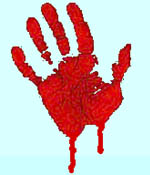 Blood Ritual |
 New America |
| Navigate This Site | |
 | |
| Home | |
| Valentine | |
| Dilling | |
| Talmud | |
| The Rabbis | |
| Supplement | |
| Glossary | |
| Download | |
| Admin | |
Endnotes:
- This and other Come and Hear™ Studies on Talmudic Judaism can be found online:
- http://www.come-and-hear.com/editor
- The Jewish Religion: Its Influence Today by Elizabeth Dilling, complete with all 300 exhibits, can be found online:
- http://www.come-and-hear.com/dilling
- Soncino Babylonian Talmud tractates, with Forewords, Introductions, Glossary, List of Abbreviations, and footnotes. Now you can study the Babylonian Talmud in full context and with the running commentary of the finest scholars of Judaism:
- Tractate Berakoth: http://www.come-and-hear.com/berakoth
- Tractate Shabbath: http://www.come-and-hear.com/shabbath
- Tractate Yebamoth: http://www.come-and-hear.com/yebamoth
- Tractate Kethuboth: http://www.come-and-hear.com/kethuboth
- Tractate Nedarim: http://www.come-and-hear.com/nedarim
- Tractate Nazir: http://www.come-and-hear.com/nazir
- Tractate Sotah: http://www.come-and-hear.com/sotah
- Tractate Gittin: http://www.come-and-hear.com/gittin
- Tractate Baba Kamma: http://www.come-and-hear.com/babakamma
- Tractate Baba Mezi'a: http://www.come-and-hear.com/babamezia
- Tractate Baba Bathra: http://www.come-and-hear.com/bababathra
- Tractate Sanhedrin: http://www.come-and-hear.com/sanhedrin
- Tractate Abodah Zarah: http://www.come-and-hear.com/zarah
- Tractate Horayoth: http://www.come-and-hear.com/horayoth
- Tractate Niddah: http://www.come-and-hear.com/niddah
- Tractate Tohoroth: http://www.come-and-hear.com/tohoroth
- Search the Talmud http://www.come-and-hear.com/tindex.html
- Download all the above resources for local study, CD, or mirror web site:
- http://www.come-and-hear.com/download
Appendix: Moses in Heaven
The following aggadah tells of the Jewish belief concerning Moses visiting Heaven and receiving the Torah from Yahweh. The Jewish Encyclopedia terms this story a "legend," and it is not held as an article of faith by all branches of Judaism.
From Shabbath 88b (Soncino 1961 Edition, pages 421-425):
GEMARA. … R. Joshua b. Levi also said: When Moses ascended on high, the ministering angels spake before the Holy One, blessed be He, 'Sovereign of the Universe! What business has one born of woman amongst us?' 'He has come to receive the Torah,' answered He to them. Said they to Him, 'That secret treasure, which has been hidden by Thee for nine hundred and seventy-four generations before the world was created. Thou desirest to give to flesh and blood! What is man, that thou art mindful of him, And the son of man, that thou visitest him? O Lord our God, How excellent is thy name in all the earth! Who hast set thy glory [the Torah] upon the Heavens!' 'Return them an answer,' bade the Holy One, blessed be He, to Moses. 'Sovereign of the Universe' replied he, 'I fear lest they consume me with the [fiery] breath of their mouths.' 'Hold on to the Throne of Glory,' said He to him, 'and return them an answer,' as it is said, He maketh him to hold on to the face of his throne, And spreadeth [PaRSHeZ] his cloud over him, whereon R. Nahman observed: This teaches that the Almighty [SHaddai] spread [Pirash] the lustre [Ziw] of His Shechinah and cast it as a protection over him. He [then] spake before Him: Sovereign of the Universe! The Torah which Thou givest me, what is written therein? I am the Lord thy God, which brought thee out of the Land of Egypt. Said he to them [the angels], 'Did ye go down to Egypt; were ye enslaved to Pharaoh: why then should the Torah be yours? Again, What is written therein? Thou shalt have none other gods: do ye dwell among peoples that engage in
Shabbath 89a
idol worship? Again what is written therein? Remember the Sabbath day, to keep it holy: do ye then perform work, that ye need to rest? Again what is written therein? Thou shalt not take [tissa] [the name … in vain]: is there any business [massa] dealings among you? Again what is written therein, Honour thy father and thy mother; have ye fathers and mothers? Again what is written therein? Thou shall not murder. Thou shalt not commit adultery. Thou Shall not steal; is there jealousy among you; is the Evil Tempter among you? Straightway they conceded [right] to the Holy One, blessed be He, for it is said, O Lord, our Lord, How excellent is thy name, etc. whereas 'Who has set thy glory upon the heavens' is not written. Immediately each one was moved to love him [Moses] and transmitted something to him, for it is said, Thou hast ascended on high, thou hast taken spoils [the Torah]; Thou hast received gifts on account of man: as a recompense for their calling thee man [adam] thou didst receive gifts. The Angel of Death too confided his secret to him, for it is said, and he put on the incense, and made atonement for the people; and it is said, and he stood between the dead and the living, etc. Had he not told it to him, whence had he known it?
R. Joshua b. Levi also said: When Moses descended from before the Holy One, blessed be He, Satan came and asked Him, 'Sovereign of the Universe! Where is the Torah? 'I have given it to the earth.' answered He to him. He went to the earth and said to her, 'Where is the Torah?' 'God understandeth the way thereof, etc.' she replied. He went to the sea and it told him, 'It is not with me.' He went to the deep and it said to him, 'It is not in me,' for it is said. The deep saith, It is not in me: And the sea saith, It is not with me. Destruction and Death say, We have heard a rumour thereof with our ears. He went back and declared before Him, 'Sovereign of the Universe! I have searched throughout all the earth but have not found it!' 'Go thee to the son of Amram. answered He. [So] he went to Moses and asked him, 'Where is the Torah which the Holy One, blessed be He, gave unto thee?' 'Who am I then,' he retorted, 'that the Holy One, blessed be He, should give me the Torah?' Said the Holy One, blessed be He, to Moses, 'Moses, art thou a liar!' 'Sovereign of the Universe!' he replied, 'Thou hast a stored-up treasure in which Thou takest delight every day: shall I keep the benefit for myself?' 'Said the Holy One, blessed be He, to Moses, 'Moses, since thou hast [humbly] disparaged thyself, it shall be called by thy name, as it is said, Remember ye the law of Moses my servant.
R. Joshua b. Levi also said: When Moses ascended on high, he found the Holy One, blessed be He, tying crowns on the letters [of the Torah]. Said He to him, 'Moses, is there no [greeting of] Peace in thy town?' 'Shall a servant extend [a greeting of] Peace to his Master!' replied he: 'Yet thou shouldst have assisted Me,' said He. Immediately he cried out to Him, And now, I pray thee, let the power of the Lord be great, according as thou hast spoken.
R. Joshua b. Levi also said: Why is it written; And when the people, saw that Moses delayed [boshesh] [to come down from the mount]? 'Read not boshesh' [delayed] but ba'u shesh [the sixth hour had come]. When Moses ascended on high, he said to Israel, I will return at the end of forty days, at the beginning of the sixth hour. At the end of forty days Satan came and confounded the world. Said he to them: 'Where is your teacher Moses?' 'He has ascended on high,' they answered him. 'The sixth [hour] has come,' said he to them, but they disregarded him. 'He is dead' — but they disregarded him. [Thereupon] he showed them a vision of his bier, and this is what they said to Aaron, for this Moses, the man, etc.,
One of the Rabbis asked R. Kahana: Hast thou heard what the mountain of Sinai [connotes]? The mountain whereon miracles [nissim] were performed for Israel, he replied. Then it should be called Mount Nisal? But [it means] the mountain whereon a happy augury [siman] took place for Israel. Then it should be called, Mount Simanai? Said he to him, Why dost thou not frequent [the academy of] R. Papa and R. Huna the son of R. Joshua, who make a study of aggadah. For R. Hisda and Rabbah the son of R. Huna both said, What is [the meaning of] Mount Sinai? The mountain whereon there descended hostility [sin'ah] toward idolaters. And thus R. Jose son of R. Hanina said: It has five names: The Wilderness of Zin, [meaning] that Israel were given commandments there; the Wilderness of Kadesh, where the Israelites were sanctified [kadosh], the Wilderness of Kedemoth, because a priority [kedumah] was conferred there; the Wilderness of Paran,
Shabbath 89b
because Israel was fruitful [paru] and multiplied there; and the Wilderness of Sinai, because hostility toward idolaters descended thereon. Whilst what was its [real] name? Its name was Horeb. Now they disagree with R. Abbahu, For R. Abbahu said: its name was Mount Sinai, and why was it called Mount Horeb? Because desolation [hurbah] to idolaters descended thereon.
